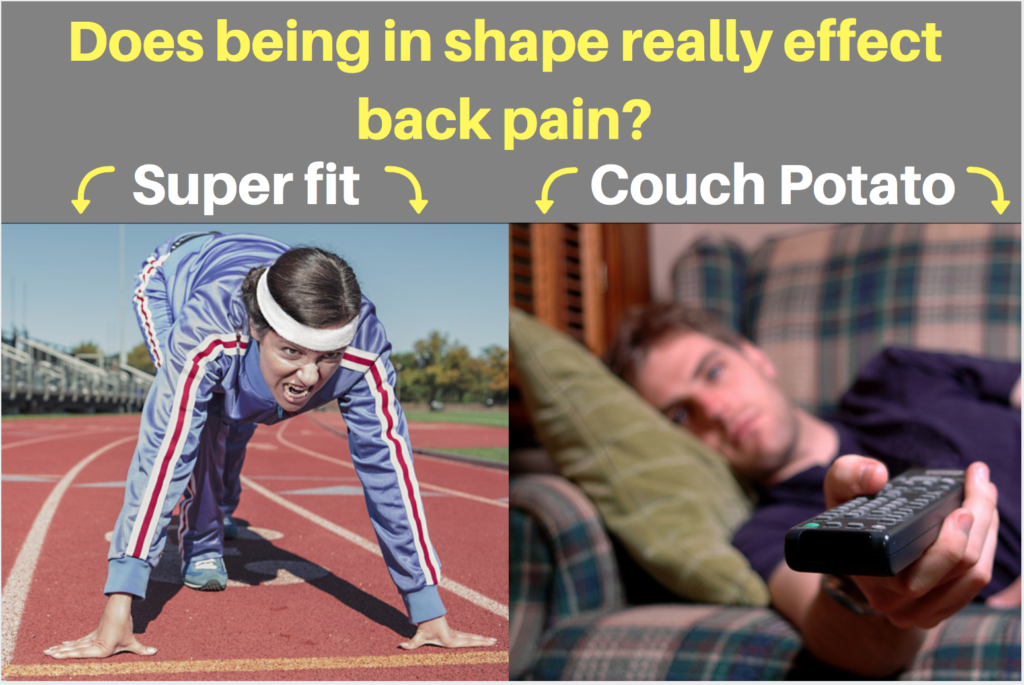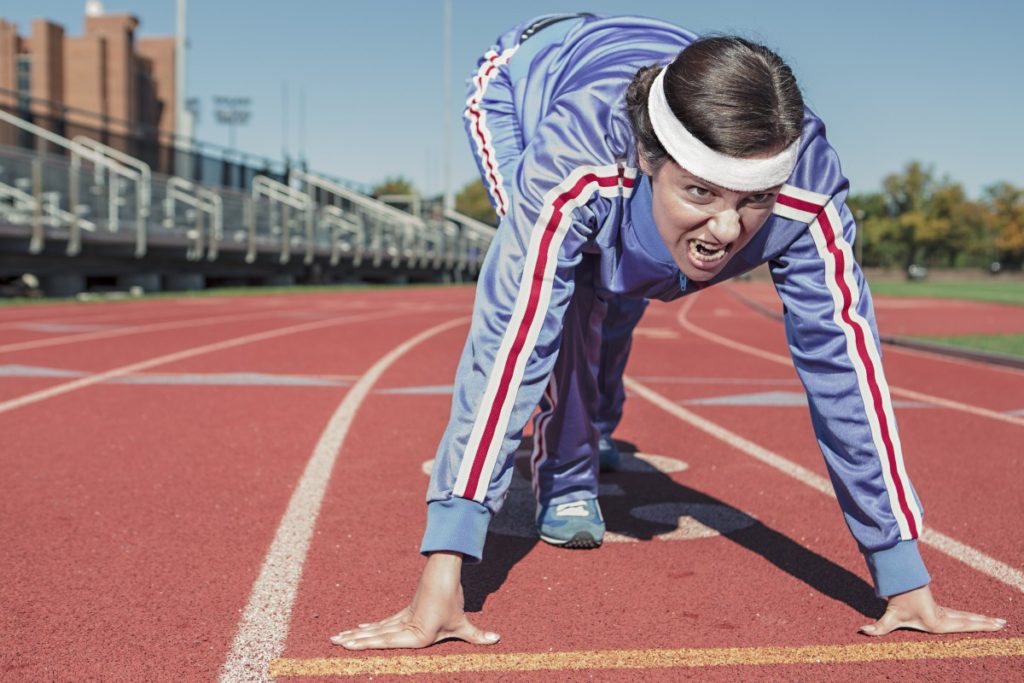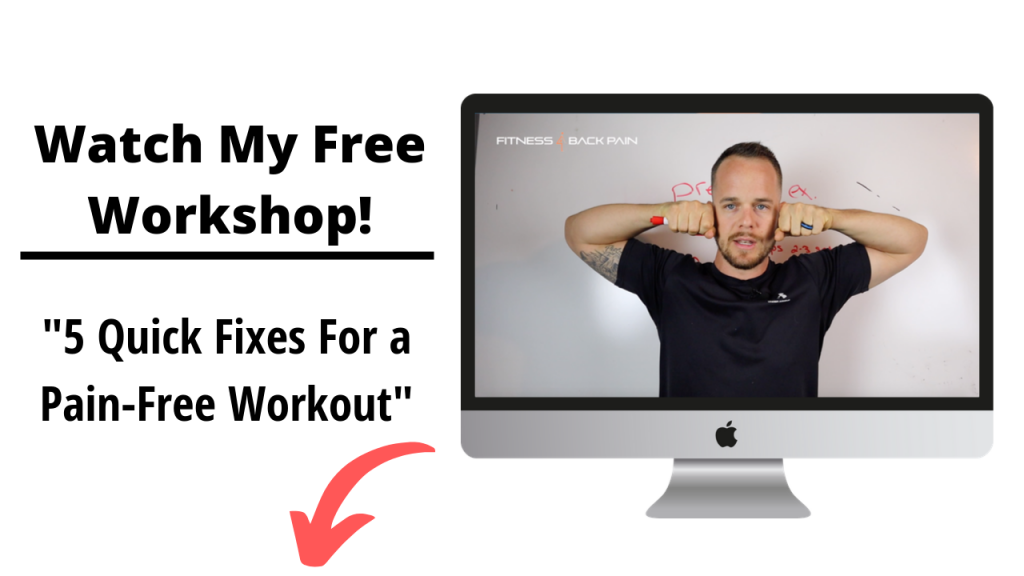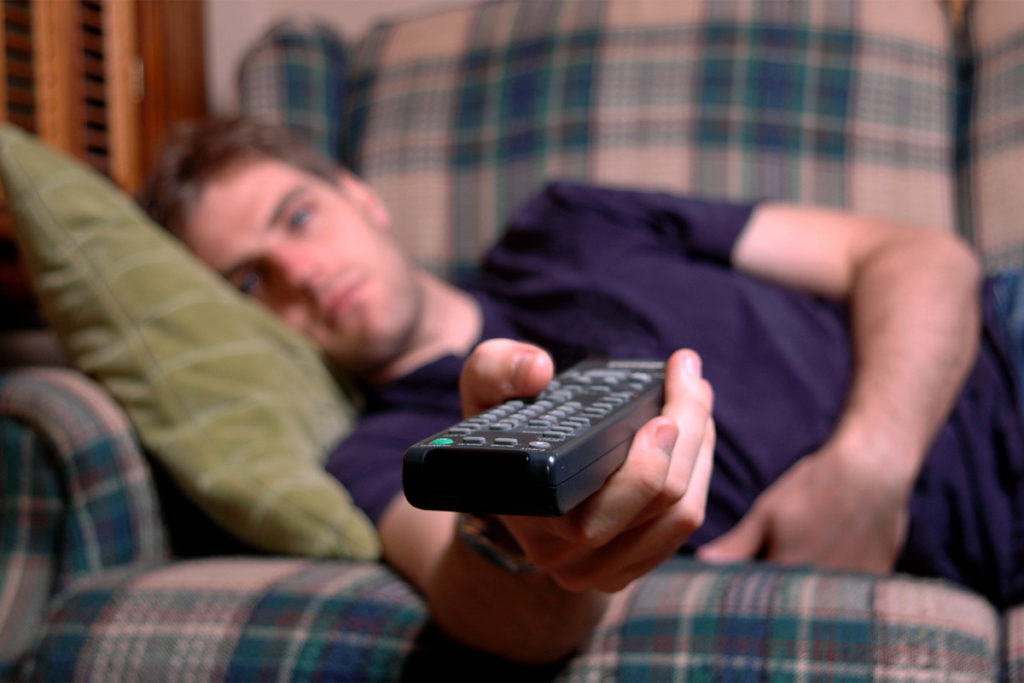
If you have been convinced by the fitness and medical industry that being in better shape equals less pain I am going to pop that bubble today. Both the super fit and couch potato have their own mountains to climb but are no different once they enter into the world of living with chronic back pain. Its time we stop trying to reach this unobtainable level of being fit and start focusing on what matters.
A lot of back pain sufferers fall into two categories.
- I Workout, Crossfit, Run or am super active most days of the week but I can’t seem to shake this back pain no matter how I structure my workouts.
- I am not active much at all most days of the week and I can’t seem to shake this back pain.
Despite these two different types of people they have the same issue. They can’t seem to shake their pain. Which to me leads me to the discussion of is being “more fit or active” better to relieve back pain.
We are going to hammer this topic today focusing a lot on why even the “super fit” struggle to find relief from their pain.
Over the past 7+ years, I have been massively let down on the blanket statement “Just be more/stay active to get relief from your back pain”. It’s just another good idea that carries a lot of weight but still leaves a lot of people discouraged and not finding relief.
-
It’s not how fit you are but how you use your body to become “fit”.
These two types of people are very different but one thing stands true is they both need to learn to respect their own process. Each person has their end goal in site but their steps will be a little different.
Let’s break this down

Non-negotiables for the Super-fit
Stop working out.
Yes, I said stop working out. I typically try to find a way to allow you to keep working out but this only slows your recovery process down. You need to give your spine a break. No squatting, deadlifting, twisting, planking, pulling, curling or pressing. Let your spine rest for 1-3 months at least.
After time off you can do a good evaluation of what is going on. From there if you’re still not sure, I suggest focusing primarily on the 3 pillars of back pain relief. Core stability, muscle endurance, and movement mechanics. With any student that I work with this is the exact protocol that I typically follow.
If you have never thought about the impact a workout can have on a bad back you need to check this article out! Number 8 is huge!
Stop Justifying your workouts or trying to both recover and train at the same time.
I am all for working out but what I don’t understand are the people who want to get relief but hearing me say “you need to take time off” (and mean more than just a few days) is not an option. You want to quit smoking but taking out your morning trip to the 7-11 to buy a pack of smokes and a diet coke is not an option. You will never quite with that mentality. When it comes to the early stage of back pain recovery your options are very limited as far as what you should be doing. Take it from a guy who never fully committed to the process. I am impatient and when I was allowed to add in workouts I would go from zero to sixty and have to take two steps back. I did this for years and it didn’t do anything but extend my recovery time and keep me on my pain cycle.
Come to terms with what may have to change.
My goal for every single one of my students is to be able to get back to working out or living the life they had before back pain came in and changed everything. I know there are a lot of coaches out there talking about how squatting is like breathing and how everyone should be able to load their spine and squat pain-free or how important deadlifts are.
I agree with a lot of this but what that does to the consumer (you the back pain sufferer) is you tend to add this stuff back in too soon. You hear its good to do from your favorite Instagram content creator so you keep trying every couple of weeks and end of delaying your recovery simply because your body just wasn’t ready. I didn’t load my spine or deadlift for over 2 years before I even got back into playing with variations of the exercise. My mechanics were jacked up and I needed time to fix these things and allow my body to heal. Now, 2 years is a long time and it wasn’t necessarily planned that way but I just felt better not trying to chase after these two exercises. I learned to challenge my body in other ways that didn’t involve these specific exercises.
Even today, if you said I would never bar squat again, I would be cool with that. In my experience, I have learned to give and take. I love working out and staying active but I hate back pain. If taking something out simply to keep my spine happy then it’s better to play the long game with my life than anything else.
Everything Matters
I’ll be straight-forward with you on this one. If you are not willing to audit your life and leave no stone unturned when it comes to posture and daily habits with your mechanics then you will never recover to your full potential. It goes way deeper than your form during a lift. It’s the way you bend to wash your body in the shower, the way you rack and unrack your weights, the way you load and unload your gym bag, brush your teeth and stare at your phone in between sets all play a role in the early stages of recovery. This stuff can become more lax when your body has fully recovered but out of the gate, your whole life needs to change.
Only a few people reading this will truly take this to heart and realize how much potential they are missing. What will it take for you to fully commit to your body doing a full recovery?
I had to cut this list short but here are 25 things you do that have a major impact on your lower back.
Non-negotiables for the Couch potato
Move more (walk, garden, cycle, hike, swim)
Notice I didn’t say lift weights or take up some weird high impact sport. Just move. You have got to move your body. If working out is not a “thing” for you that’s okay then beating your back pain and having a full recovery after your fusion or other spine surgery has to become your “thing”. Stop sitting all day just to hop in your car and commute an hour home then sit at a table and eat dinner then sit on the couch to get in some TV time.
Believe me, I know the struggle and how hard it is to take static sitting out and put more movement in. The key is to get into more dynamic movement activities.
Let me throw you a curveball.
Simply walking isn’t enough. Give your body variety so it gets used to activating muscles and joints through multiple planes of movement. If all you do is walk then start hiking on uneven terrain or start swimming. Give your body opportunity to work in different ways.
Swimming for example, is a great way to challenge the tissue of the body in different ways that you can’t from just walking a few miles. This is a great way to break up adhesions in the hips and low back and invite healthy movement, blood and oxygen into the area. You don’t even have to swim laps just jump in and tread water. You have to use your entire body to do this!
Fix Your Vitals (Core Stability, Muscle Endurance, and Mechanics)
If you’re looking to kick your pain medication prescription and try beating back pain on your own there are 3 areas I would suggest you focus on for now. Core Coordination (strength, endurance, stability with movement), Muscle Endurance and your movement mechanics. Odds are you haven’t really thought about how well your core muscles work at stabilizing your spine. Which is why I try to get you to focus on more endurance type exercises than anything else. Your goal is to bring your body up to speed with your lifestyle. For years your body and how it supports your daily life has been a second thought. This has to change and its done one day at a time creating new habits around healthy decisions.
I did a pretty cool series on this you can check them out here!
Part 1: First 2 steps
Part 2: Breathing, Bracing and Finding neutral
Part 3: Your feets impact on your back pain
Pursue balance, not perfection or some unsustainable super active lifestyle.
I am big on making small steps towards big goals and seeing progress even when it doesn’t seem to be there. I talk about how you can use my own prsonal strategy to gaurantee progress!
It’s not about becoming super fit but being fit to sustain your life. If you sit all day you have to actively be pursuing a more “standing lifestyle” both at work and at home. If you stand all day you have to pursue rest for your muscles and joints. It’s a balance that you can’t really calculate you have to just go off of how your body feels and what it’s telling you. I have had weeks were doing more sitting was actually more restful for my lower back. I have also had weeks were standing and constantly moving was what I had to do to keep control over my pain. I am an advocate of getting EVERYONE into working out no matter what that looks like for each person. I know movement heals what I want to try to do with this site is teach you the HOW when it comes to movement.
-What does balance look like?
Break up your sitting with an alarm that reminds you to get up every 45 minutes or so while you work and give yourself GOOD excuses to walk away from sitting and get in some movement. For example, I try to drink lots of water so this forces me to constantly be refilling my bottle and getting up to use the bathroom. This is a way to get up and get moving. I will sometimes add a little longer of a walk into this bottle refill or do some stretches that will help undo what the sitting is doing. I bring lunches to work that requires some preparation not just open the fridge grab the Tupperware and toss it in the microwave. GIve your lunch some thought and allow yourself to practice standing with good posture and using your core, glutes and other key muscles to go through this activity.
When it comes to exercise I suggest starting with an activity that you love. If your 30,50,60+ years old and have never exercised odds are you are not going to just jump in and hit the ground running. I suggest getting into an old hobby whether that is bike riding, tennis, skating, soccer whatever. Start with something you enjoy than work up from there.
Everything matters
From the way you brush your teeth, to the way you tie your shoes, to the way you take the trash bag out of the bin and put a new one in. It all matters. If you still believe the crap that the medical industry has taught us that if you do your PT three times a week and do your homework you will be A-OK.
This is only part of your recovery. Real long-term relief requires more than that. It requires you to audit your entire life and ruthlessly pursue the destruction of your own pain cycle. The way you stand, the way you breathe, the way you bend and twist to the way you lift. It doesn’t matter what it is your doing, it all matters.
I say this not to scare you or overwhelm you as a sufferer but my passion is to teach you how to address each one of these key areas in your life with simple step by step applications. All you need is determination and patience as you work through the process.
If you are wondering where and when you should apply these tips i would suggest starting immediately. Starting tomorrow I want you to make note of the amount of times you bend, twist and for how long you sit. If you’re a gym goer, I don’t want you thinking about your form in the gym but focusing on your form during the rest of your day. These techniques only work if you implement them every day and into every inch of your being.
Where are you with your recovery? Are you a couch potato with back pain or are you an active gym goer who can’t seem to get a hold of their pain?
Let me know who you are in the comments below!
Addicted to your health,
William



Great advice, William. Love the advice that you give here and in all your articles. As an ex-runner who could regularly run 32minutes for 10km, I began to struggle with quadratus lumborum and mid-back issues when I stupidly tried to change my running style, thinking it would lead to faster running times. I’m still on the road to recovery, but your advice is full of common sense and keeps me going. I’m learning that patience is so important, as is keeping my ego in check.
Hey Matt!
Patience is huge! Knowing when to push forward and when to pull back is key! Thanks for reading and your response!
That was brilliant.
3-4 years ago I developed lumbar pain from hockey, running and driving a computer for 25 years. So I did what back pain sufferers do and I went to yoga. Because yoga is the miracle cure-all for back pain, right? Sure enough, after yoga I’d feel better. For a while. But the pain would return.
So, I did more yoga, and the pain got worse. More pain, more yoga, more yoga, more pain. Eventually 4-5 times a week, and the pain got worse.
Then I had the opportunity to attend a seminar with Dr. McGill where I learned that, due to my particular anatomy, the types of yoga I was doing were not only NOT helping my back pain, they were actually exacerbating it.
Long story short, I ended up going through the exact process you outlined for the fit. Time off, assess, and relearn core strength, stability and movement.
Like I said, brilliant.
Andrew! Thanks so much for your comment brother! Glad to see the light bulb going off! Stay focused on making these changes every day and your body WILL change.
Cheers!
William